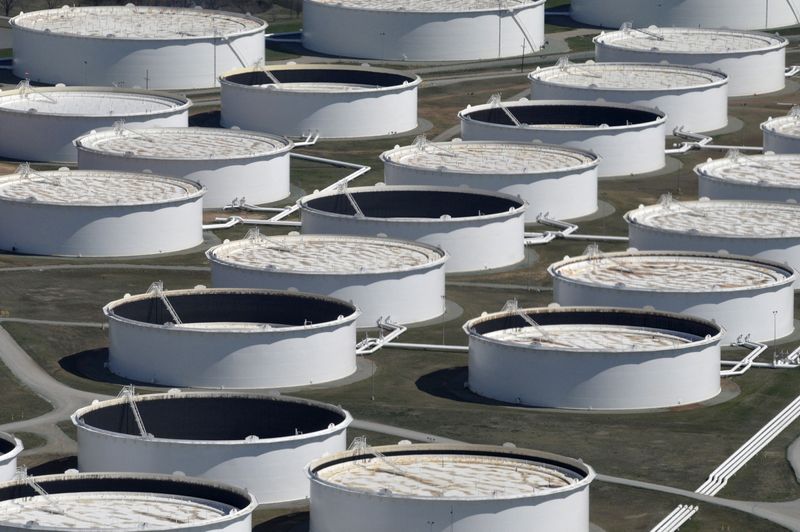Commodities
Oil ends week lower as demand concerns face Russia supply ban


© Reuters. FILE PHOTO: Crude oil storage tanks are seen from above at the Cushing oil hub, appearing to run out of space to contain a historic supply glut that has hammered prices, in Cushing, Oklahoma, March 24, 2016. REUTERS/Nick Oxford//File Photo
By Arathy Somasekhar and Nicole Jao
HOUSTON (Reuters) -Oil prices held steady on Friday but closed the week lower on profit-taking and as markets weighed supply concerns stemming from Russia’s fuel export ban against demand woes from future rate hikes.
futures settled 3 cents lower at $93.27 a barrel. It fell 0.3% in the week, breaking a three week streak of gains.
U.S. West Texas Intermediate crude (WTI) futures rose 40 cents, or 0.5%, to $90.03 a barrel, as U.S. oil rig counts fell. The benchmark fell 0.03% for the week, the first decline in four weeks.
“Investors are anticipating a slack in demand coming into October as refineries go into maintenance and as a higher interest rate is going to further pressure markets,” said Dennis Kissler, senior vice president of trading at BOK Financial, adding that there was also some profit taking.
The contracts have rallied more than 10% in the previous three weeks on concerns about tight supply.
U.S. Federal Reserve officials warned of further rate hikes, even after voting to hold the benchmark federal funds rate steady at a meeting this week.
“Inflation is still too high, and I expect it will likely be appropriate for the (Federal Open Market) Committee to raise rates further and hold them at a restrictive level for some time,” Fed Governor Michelle Bowman said.
A potential further rise in energy prices, she noted, was a particular risk she was monitoring.
Higher interest rates increase borrowing costs, which could slow economic growth and reduce oil demand.
Meanwhile, Russia’s temporary ban on exports of gasoline and diesel to most countries was expected to tighten supplies.
Russia’s Transneft suspended deliveries of diesel to the key Baltic and Black Sea (NYSE:) terminals of Primorsk and Novorossiysk on Friday, state media agency Tass said.
The ban will “bring new uncertainty into an already tight global refined product supply picture and the prospect that the impacted countries will be seeking to bid up cargoes from alternative suppliers,” RBC said in a note.
Russian wholesale gasoline prices were down nearly 10% and diesel down 7.5% on Friday on the St. Petersburg International Mercantile Exchange.
U.S. oil rig counts, an indicator of future production, also fell by eight to 507 this week, their lowest since February 2022, energy services firm Baker Hughes said.
Refineries in the United States routinely do maintenance in autumn after heavy runs to meet fuel demand from the summer driving season. Offline refinery capacity was expected to reach 1.4 million barrels per day (bpd) this week according to IIR Energy versus 800,000 bpd offline last week.
Money managers raised their net long futures and options positions in the week to Sept. 19, the U.S. Commodity Futures Trading Commission said.
Commodities
Oil prices rise; U.S. crude inventories plunge, Russia-Ukraine truce eyed
Commodities
India’s Reliance to stop buying Venezuelan oil over US tariffs, sources say
Commodities
Oil prices climb on Venezuela supply worries

 Forex3 years ago
Forex3 years agoForex Today: the dollar is gaining strength amid gloomy sentiment at the start of the Fed’s week

 Forex3 years ago
Forex3 years agoUnbiased review of Pocket Option broker

 Forex3 years ago
Forex3 years agoDollar to pound sterling exchange rate today: Pound plummeted to its lowest since 1985

 Forex3 years ago
Forex3 years agoHow is the Australian dollar doing today?

 Cryptocurrency3 years ago
Cryptocurrency3 years agoWhat happened in the crypto market – current events today

 World3 years ago
World3 years agoWhy are modern video games an art form?

 Commodities3 years ago
Commodities3 years agoCopper continues to fall in price on expectations of lower demand in China

 Economy3 years ago
Economy3 years agoCrude oil tankers double in price due to EU anti-Russian sanctions























